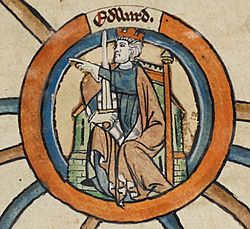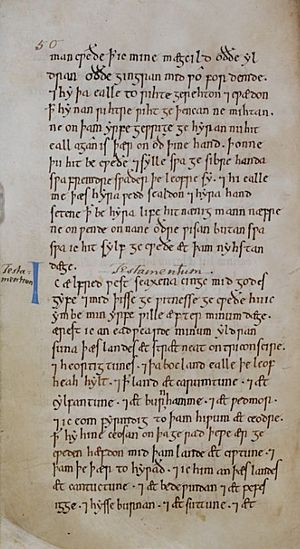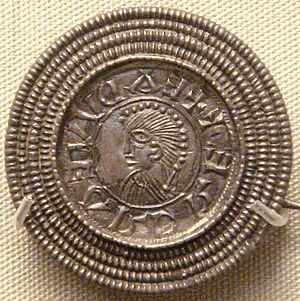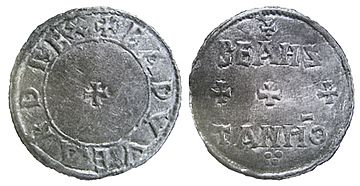Edward the Elder facts for kids
Quick facts for kids Edward the Elder |
|
|---|---|

Portrait miniature from a thirteenth-century genealogical scroll depicting Edward
|
|
| King of the Anglo-Saxons | |
| Reign | 26 October 899 – 17 July 924 |
| Coronation | 8 June 900 Kingston upon Thames |
| Predecessor | Alfred the Great |
| Successor | Æthelstan (or Ælfweard, disputed) |
| Born | c. 874 |
| Died | 17 July 924 Farndon, Cheshire, Mercia |
| Burial | New Minster, Winchester, later translated to Hyde Abbey |
| Spouse | |
| Issue more ... |
|
| House | Wessex |
| Father | Alfred the Great |
| Mother | Ealhswith |
Edward the Elder (born around 874, died 17 July 924) was the King of the Anglo-Saxons from 899 until his death. He was the oldest son of Alfred the Great and his wife Ealhswith. When Edward became king, he had to fight his cousin Æthelwold, who also wanted the throne.
Edward's father, King Alfred, had fought against the Vikings and won a big victory at the Battle of Edington in 878. After this, the Vikings still controlled northern and eastern England. Alfred became known as the King of the Anglo-Saxons, ruling all English people not under Viking control. Edward took on this important title when Alfred died in 899.
Edward worked with his sister, Æthelflæd, to conquer the Viking-controlled areas in southern England. After Æthelflæd died in 918, Edward took full control of Mercia. By the end of his reign, he ruled most of England south of the Humber River. He died in 924 and was followed by his oldest son, Æthelstan. Edward's younger sons, Edmund I and Eadred, also became kings later.
Historians today see Edward as a very important king. He helped destroy the Vikings' power in southern England. He also laid the groundwork for a united English kingdom, which was centered in the south.
Contents
Edward's Early Life and Family

Edward's parents, Alfred and Ealhswith, got married in 868. His mother, Ealhswith, came from an important family in Mercia. Edward had five siblings who lived to be adults. His older sister, Æthelflæd, later became the powerful Lady of the Mercians. His younger brother, Æthelweard, received a special education.
Historians believe Edward was born in the mid-870s. He was likely named "Edward," which means "protector of wealth." This name was new for the West Saxon royal family. It might have been chosen to show stronger ties with Mercia, his mother's home.
Edward and his younger sister, Ælfthryth, were educated at the royal court. They had tutors who taught them about religious and everyday topics in English. They learned important qualities like gentleness and humility. This was unusual because a prince and princess usually didn't get the same kind of education.
Becoming a Prince and Leader
As a king's son, Edward was an ætheling, meaning he was eligible to become king. Even though he was the oldest son, his path to the throne was not guaranteed. His cousins, Æthelhelm and Æthelwold, also had claims because their father was Alfred's older brother and a previous king.
King Alfred made sure Edward had many advantages. In his will, Alfred left most of his land and wealth to Edward. He also promoted people who would support Edward as the next king. Edward often went with his father on royal trips and witnessed many important documents.
When Edward grew up, Alfred gave him military commands. This helped Edward gain experience in leading armies. In 893, Edward led troops and defeated the Vikings at the Battle of Farnham. This showed he was a strong leader, which was important for becoming king.
Around 893, Edward likely married Ecgwynn. They had two children: Æthelstan, who would later become king, and a daughter who married a Viking king of York. After Ecgwynn probably died, Edward married Ælfflæd around 899.
Æthelwold's Challenge to the Throne
Alfred died on 26 October 899, and Edward became king. However, his cousin Æthelwold challenged him for the throne. Æthelwold took control of royal lands at Wimborne Minster and Christchurch, Dorset. Edward marched his army to a nearby fort. Æthelwold then fled to Northumbria, where the Danes accepted him as their king. Edward was crowned on 8 June 900 at Kingston upon Thames.
In 901, Æthelwold came back with a fleet to Essex. The next year, he convinced the Danes in East Anglia to attack English Mercia and northern Wessex. Edward fought back by attacking East Anglia. On 13 December 902, Edward's army met the Danish army at the Battle of the Holme. The Danes won the battle, but they lost many important leaders, including Æthelwold himself. This ended the threat to Edward's rule.
Edward: King of the Anglo-Saxons
In 886, King Alfred had taken the title Anglorum Saxonum rex (King of the Anglo-Saxons). This meant he ruled all English people not under Danish control. Edward inherited this important title. It showed that he ruled both the West Saxons and the Mercians.
Some historians believe that Mercia kept some independence until Edward's sister, Æthelflæd, died in 918. However, Edward's charters (official documents) show that Mercian leaders acknowledged his authority. The Anglo-Saxon Chronicle, written at the West Saxon court, often showed Edward's power.
Marriages with the West Saxon royal family were seen as very important by rulers in other parts of Europe. Edward's daughter Eadgifu married Charles the Simple, the King of the West Franks. After Edward's death, another daughter, Eadgyth, married Otto I, who would become the King of Germany and later a Holy Roman Emperor.
Conquering the Southern Danelaw
After the Battle of the Holme, there were no major battles for several years. In 906, Edward made peace with the Danes in East Anglia and Northumbria. This suggests he might have had to pay them to stop fighting. He also encouraged English people to buy land in Danish areas.
In 909, Edward sent an army to attack the Northumbrian Danes. They took the bones of the saint Oswald from Bardney Abbey. The Danes were forced to make peace on Edward's terms. The next year, the Northumbrian Danes raided Mercia, but Edward's combined army defeated them badly at the Battle of Tettenhall. After this, the Northumbrian Danes stayed north of the Humber River. This allowed Edward and his Mercian allies to focus on conquering the southern Danelaw. This area included East Anglia and the Five Boroughs (Derby, Leicester, Lincoln, Nottingham, and Stamford).
In 911, Æthelred, Lord of the Mercians, Edward's brother-in-law, died. Edward took control of Mercian lands near London and Oxford. Æthelred's wife, Edward's sister Æthelflæd, became the Lady of the Mercians and continued to rule.
Edward and Æthelflæd then started building many forts. These forts helped protect against Viking attacks and secure newly captured lands. For example, in 911, Edward built a fort at Hertford to defend against the Danes. In 912, he built another fort at Witham in Essex. These forts helped protect London and encouraged many English people living under Danish rule to join Edward.
In 914, a Viking army from Brittany attacked the Severn area. Edward's armies defeated them. In late 914, Edward built two forts at Buckingham, and a Danish leader named Earl Thurketil submitted to him. The next year, Edward occupied Bedford and built another fort there.
The year 917 was very important for the war. Edward built forts at Towcester and Wigingamere. The Danes attacked these forts but failed. Meanwhile, Æthelflæd captured Derby. The English also stormed the Viking fort at Tempsford and killed the last Danish king of East Anglia. The English then took Colchester. The Danes tried to attack Maldon, but the English held out and defeated them. Edward then strengthened the fort at Towcester with a stone wall. The Danes of Northampton, Cambridge, and East Anglia all submitted to him. By the end of 917, only four of the Five Boroughs (Leicester, Stamford, Nottingham, and Lincoln) were still under Danish control.
In early 918, Æthelflæd took Leicester without a fight. The Danes in York offered to join her, probably for protection against other Vikings. However, she died on 12 June. After her death, her daughter Ælfwynn briefly ruled Mercia. But in December 918, Edward took Ælfwynn into Wessex and took direct control of Mercia. This meant Mercia was now fully under his rule. Stamford and Nottingham also surrendered to Edward. By this point, Edward ruled all of England south of the Humber River. Three Welsh kings also pledged their loyalty to Edward.
Royal Money and the Church
During Edward's reign, the main money was the silver penny. His coins had his name, "EADVVEARD REX," on one side and the name of the money maker on the other. Mints (places where coins are made) were in many towns like Bath, Canterbury, London, and Winchester. The number of money makers increased a lot during his rule, showing his growing power.
Edward also made changes to the church. In 909, he divided the large diocese (church area) of Winchester into two. He also divided Sherborne into three dioceses. These changes helped strengthen the power of Canterbury compared to other church centers. They also helped bishops become more involved in local government and defense.
In 901, Edward started building a large new monastery for men in Winchester, called the New Minster. It was meant to be a royal burial place. Edward moved his father Alfred's body there, and he himself was buried there when he died. However, his son Æthelstan did not favor this new monastery.
Laws and Administration
Edward's reign saw changes in how laws were made and how the kingdom was run. He made laws about land ownership, especially "bookland," which was land given by royal charter. He wanted disputes over land to be settled quickly.
Historians don't have many official documents (charters) from Edward's later reign. This might be because he kept more land for himself to help pay for his wars against the Vikings.
Edward's rule helped create a more centralized kingdom. This means that power was more focused in the king's hands. This system, with its shires (regions) and royal officials, helped make Anglo-Saxon England one of the most organized kingdoms in Western Europe at the time.
Later Life and Legacy
In 920, the Anglo-Saxon Chronicle says that many rulers in Britain, including the King of the Scots and leaders in Northumbria and Wales, chose Edward as their "father and lord." This suggests they accepted his authority. However, some historians believe this was more of a treaty between kings than a full submission.
Edward continued to build forts in the north-west, like at Thelwall and Manchester. In 924, he put down a revolt in Mercia and Wales at Chester. He died shortly after, on 17 July 924, at Farndon. He was buried in the New Minster in Winchester. Later, his remains were moved to Hyde Abbey.
Medieval writers admired Edward, especially for his military success. They often said he was not as good at learning as his father, Alfred, but was a better ruler in terms of power. He was called "the most invincible King Edward the Elder." However, his achievements were sometimes overlooked because he didn't have one single famous victory like his father or his son, Æthelstan. He was also overshadowed by his famous sister, Æthelflæd.
For a long time, modern historians didn't pay much attention to Edward. But in recent years, his reputation has grown. Historians now see him as a key figure who destroyed Viking power in southern England. He also helped build the strong foundations for a united English kingdom. Historian Nick Higham called him "perhaps the most neglected of English kings." Edward's nickname "the Elder" was first used later to tell him apart from another king named Edward, Edward the Martyr.
Edward's Marriages and Children
Edward had about fourteen children from three marriages.
His first wife was Ecgwynn, whom he married around 893. Their children were:
- Æthelstan, who became King of England from 924 to 939.
- A daughter, possibly named Edith, who married Sitric Cáech, the Viking King of York, in 926.
Around 900, Edward married Ælfflæd. Their children included:
- Ælfweard, who died shortly after his father in 924.
- Edwin, who drowned at sea in 933.
- Eadgifu, who married Charles the Simple, King of the West Franks, around 918.
- Eadhild, who married Hugh the Great, Duke of the Franks, in 926.
- Eadgyth, who married Otto I, the future King of the East Franks and Holy Roman Emperor, in 929/30.
Edward's third marriage was to Eadgifu around 919. Their children were:
- Edmund I, who became King of England from 939 to 946.
- Eadred, who became King of England from 946 to 955.
- Eadburh, a nun who became a saint.
Edward's Family Tree
| Ancestors of Edward the Elder | |||||||||||||||||||||||||||||||||||||||||||||||||||||||||||||||||||||||||||||||||||||||||||||||||||||||||||||||||||||||||||||||||||||||||||||||||||||||||||||||||||||||||||||||||||||||||||||||||||||||||||||||||||||||||||||||||||||||||||||||||||||||||||||||||||||||||
|---|---|---|---|---|---|---|---|---|---|---|---|---|---|---|---|---|---|---|---|---|---|---|---|---|---|---|---|---|---|---|---|---|---|---|---|---|---|---|---|---|---|---|---|---|---|---|---|---|---|---|---|---|---|---|---|---|---|---|---|---|---|---|---|---|---|---|---|---|---|---|---|---|---|---|---|---|---|---|---|---|---|---|---|---|---|---|---|---|---|---|---|---|---|---|---|---|---|---|---|---|---|---|---|---|---|---|---|---|---|---|---|---|---|---|---|---|---|---|---|---|---|---|---|---|---|---|---|---|---|---|---|---|---|---|---|---|---|---|---|---|---|---|---|---|---|---|---|---|---|---|---|---|---|---|---|---|---|---|---|---|---|---|---|---|---|---|---|---|---|---|---|---|---|---|---|---|---|---|---|---|---|---|---|---|---|---|---|---|---|---|---|---|---|---|---|---|---|---|---|---|---|---|---|---|---|---|---|---|---|---|---|---|---|---|---|---|---|---|---|---|---|---|---|---|---|---|---|---|---|---|---|---|---|---|---|---|---|---|---|---|---|---|---|---|---|---|---|---|---|---|---|---|---|---|---|---|---|---|---|---|---|---|---|---|---|
|
|||||||||||||||||||||||||||||||||||||||||||||||||||||||||||||||||||||||||||||||||||||||||||||||||||||||||||||||||||||||||||||||||||||||||||||||||||||||||||||||||||||||||||||||||||||||||||||||||||||||||||||||||||||||||||||||||||||||||||||||||||||||||||||||||||||||||
See also
 In Spanish: Eduardo el Viejo para niños
In Spanish: Eduardo el Viejo para niños



